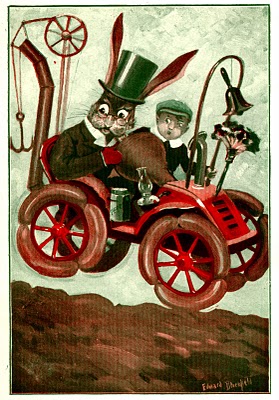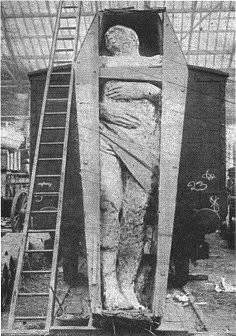
Uncle Wiggily's sausage-tired automobile fascinated me as a toddler.

The white crystals!

The infamous Cardiff Giant was Cardiff, NY's only tourist claim to fame. It's mentioned in The White Crystals several times.

Uncle Wiggily's sausage-tired automobile fascinated me as a toddler. |
 The white crystals! |
 The infamous Cardiff Giant was Cardiff, NY's only tourist claim to fame. It's mentioned in The White Crystals several times. |
The White Crystals, by Howard R. Garis, originally published 1904 by Little, Brown; limited new edition from Jim Towey's The Adventure Continues.
Howard R. Garis (1873 -- 1962) was one of the most prolific of all writers of books for children. Today he's probably best remembered for his many Uncle Wiggily short stories for very young children. Otherwise, his most widely-read books were written anonymously for the Stratemeyer Syndicate, and published under house pen names. Why would a reasonably-well-established author like Garis spend much of his career writing cookie-cutter junk such as Edward Stratemeyer peddled to the publishers? The answer is pretty simple: Stratemeyer paid promptly upon receipt of the manuscript. When an author dealt directly with publishers he usually found himself jacked around for years, even after his book was accepted and published, before receiving any substantial payment. Authors supporting a family learned to bless the name of Edward Stratemeyer. Of course, writing for Stratemeyer, the writer received no extra royalties if the book went into many printings or new editions; Stratemeyer paid a fixed, lump sum per book, usually a bit over a hundred dollars, to each of his many ghosts... who eventually included Garis's wife Lilian and their son and daughter! Under his own name, Garis also published a number of series books, beginning very shortly after The White Crystals, specifically the Dick Hamilton series, that are virtually identical to Stratemeyer fiction factory products.
While the books Garis wrote for Stratemeyer, such as the original Tom Swift series, and the today-less-well-remembered Motor Boys series, were reprinted so often that copies can still be found in almost any large used book store, the books Garis published earlier in his career are virtually unobtainable. The book in question here, The White Crystals, is among the rare, and my great gratitude goes out to Jim Towey for this attractive reprint, which has about the same size, look, feel and heft as the original. In circa 1900, when this volume saw its initial publication, boys' books were still under the heavy spell of giants such as Horatio Alger and Harry Castlemon, who dominated sales in the 1880s. Influence of both Alger and Castlemon can be detected in these pages; Garis had earlier followed along the lines of highly forgettable pseudohistorical novels such as The Whetstone of Swords, or The King of Unadilla, but the current volume is far more conventional juvenile fare of that era.
Our teen-age hero Roger Anderson, a New York City boy, is taken out of school and sent, for health reasons, to spend a year on the large farm of a relative, Bert Kimball, in rural New York state. Roger soon befriends Kimball's son Adrian, and the two spend much of the first half of the book doing farm chores, such as picking and selling grapes door to door, or picking up old bones for sale to fertilizer companies. A plot dimly appears when Bert Kimball finds the mortgage due and no money to pay it off; the boys do their part to earn what they can, but disaster is not far ahead... and then two strangers appear who seem to be secretly prospecting for some kind of mineral on Kimball's land. Our hero finds time to spy on the two, and is a witness when they find something they appear to think is of great value. What is it? Roger's attempt to find out ultimately takes him to a mining engineer in Syracuse, who steps in to save the day just when the two strangers are about to swindle Kimball out of land of great potential value. The novel is pretty episodic, and spends most of its time describing life on the farm near Cardiff, New York, including hog-killing and sausage making. There's an abrupt diversion for a bobsled race, which comes essentially out of nowhere and seems entirely separate from the rest of the novel--- but Roger also gets lost in the woods and is attacked by a wildcat--- and Roger, Adrian and the two prospectors, who are pretending to be tourists, are treed by an aggressive bear. Apart from these very few dramatic sequences, in dealing with fairly realistic farm life, Garis seems to be describing something he knows first-hand.
There are hints here and there of later work from Garis, who was only 30 when he wrote this. It's a fascinating preview of the fruits of a very long career. You won't find it even listed on Amazon.com as having ever been published in the US. It's also worth mentioning, since the fact is not generally appreciated, that according to E. F. Bleiler, the Great Marvel Series, written by Garis for Stratemeyer, is the very first connected series of science fiction novels to appear in any language! See Bleiler's Science Fiction: The Early Years (1991). [Jim Towey also offers several reprint volumes in Garis's Larry Dexter series. These feature the adventures of a young newspapear reporter in the days just before and just after the Great War (WW I to us).]
Addendum: Series book expert James Keeline had some comments on my comments, as follows. Garis wrote around 315 books for the Stratemeyer Syndicate between 1908 and 1935. The reason a number of books that appeared under Garis' own name read like Syndicate books is that they were... for example the DICK HAMILTON and CURLYTOPS series. Stratemeyer evidently allowed Garis to use his own name rather than a house name under certain conditions. [Stratemeyer and Garis were at one time very close friends.] Keeline also points out that Garis wrote only seven of the nine GREAT MARVEL titles.
Personal note: Uncle Wiggily taught me to read... at the tender age of about 4, I had my mother read the very same Uncle Wiggily story to me over and over, an ordeal that she told me in later years nearly drove her crazy. But if she tried to skip over part of the very tedious narrative I would stop her and ask her to go back, she said. That's why, at the tender age of 5, before starting school, I could already read. When, 50 years later, I tried to read some Uncle Wiggily stories again, for nostalgic reasons, I found them to be completely and totally unreadable. Thanks, Mom.
We also have a page devoted to the great editor and bibliophile Everett Franklin Bleiler, to Western pulpster Caddo Cameron, to 1930s boys' book writer William Dixon Bell, and to unique genius Harry Stephen Keeler. Then there's the house-name assembly-line pulp output of Tom Gunn (Sylvester MacDowell). Coming someday, if time and strength permit: D. E. Stevenson, Stanton A. Coblentz, E. Everett Evans and Algys Budrys.